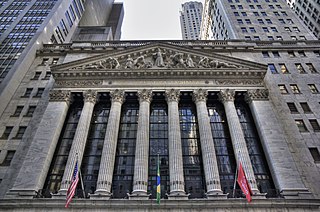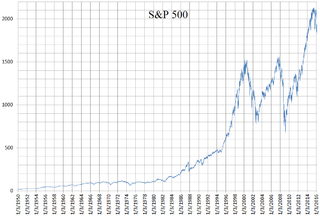
The Nasdaq Stock Market is an American stock exchange based in New York City. It is the most active stock trading venue in the U.S. by volume, and ranked second on the list of stock exchanges by market capitalization of shares traded, behind the New York Stock Exchange. The exchange platform is owned by Nasdaq, Inc., which also owns the Nasdaq Nordic stock market network and several U.S.-based stock and options exchanges.

The New York Stock Exchange is an American stock exchange in the Financial District of Lower Manhattan in New York City. It is the largest stock exchange in the world by market capitalization.

A stock exchange, securities exchange, or bourse is an exchange where stockbrokers and traders can buy and sell securities, such as shares of stock, bonds and other financial instruments. Stock exchanges may also provide facilities for the issue and redemption of such securities and instruments and capital events including the payment of income and dividends. Securities traded on a stock exchange include stock issued by listed companies, unit trusts, derivatives, pooled investment products and bonds. Stock exchanges often function as "continuous auction" markets with buyers and sellers consummating transactions via open outcry at a central location such as the floor of the exchange or by using an electronic trading platform.

The Standard and Poor's 500, or simply the S&P 500, is a stock market index tracking the stock performance of 500 of the largest companies listed on stock exchanges in the United States. It is one of the most commonly followed equity indices and includes approximately 80% of the total market capitalization of U.S. public companies, with an aggregate market cap of more than $43 trillion as of January 2024.

A corporate action is an event initiated by a public company that brings or could bring an actual change to the securities—equity or debt—issued by the company. Corporate actions are typically agreed upon by a company's board of directors and authorized by the shareholders. For some events, shareholders or bondholders are permitted to vote on the event. Examples of corporate actions include stock splits, dividends, mergers and acquisitions, rights issues, and spin-offs.
A CUSIP is a nine-character numeric or alphanumeric code that uniquely identifies a North American financial security for the purposes of facilitating clearing and settlement of trades. All CUSIP identifiers are fungible, which means that a unique CUSIP identifier for each individual security stays the same, regardless of the exchange where the shares were purchased or venue on which the shares were traded. CUSIP was adopted as an American national standard by the Accredited Standards Committee X9 and is designated ANSI X9.6. CUSIP was re-approved as an ANSI standard in December 2020. The acronym derives from Committee on Uniform Security Identification Procedures.
The Russell 1000 Index is a stock market index that tracks the highest-ranking 1,000 stocks in the Russell 3000 Index, which represent about 93% of the total market capitalization of that index. As of 31 December 2023, the stocks of the Russell 1000 Index had a weighted average market capitalization of $666.0 billion and a median market capitalization of $13.9 billion. As of 8 May 2020, components ranged in market capitalization from $1.8 billion to $1.4 trillion. The index, which was launched on January 1, 1984, is maintained by FTSE Russell, a subsidiary of the London Stock Exchange Group.
The Russell 3000 Index is a capitalization-weighted stock market index that seeks to be a benchmark of the entire U.S. stock market. It measures the performance of the 3,000 largest publicly held companies incorporated in America as measured by total market capitalization, and represents approximately 97% of the American public equity market. The index was launched on January 1, 1984, and is maintained by FTSE Russell, a subsidiary of the London Stock Exchange Group. The ticker symbol on most systems is ^RUA.
The OTC (Over-The-Counter) Bulletin Board or OTCBB was a United States quotation medium operated by the Financial Industry Regulatory Authority (FINRA) for its subscribing members. FINRA closed the OTCBB on November 8, 2021.
A Refinitiv Instrument Code, or RIC, is a ticker-like code used by Refinitiv to identify financial instruments and indices. The codes are used for looking up information on various Refinitiv financial information networks and appear to have developed from the Quotron service purchased in the 1980s.
Nalco Water, an Ecolab Company, is an American supplier of water, energy and air improvement solutions and services for industrial and institutional markets, owned by Ecolab. The company sells various products and services designed to reduce energy, water and other natural resource consumption, enhance air quality, minimize environmental releases and improve productivity and end products.
The Consolidated Tape Association (CTA) oversees the Securities Information Processor that disseminates real-time trade and quote information in New York Stock Exchange (NYSE) and American Stock Exchange (AMEX) listed securities. It is currently chaired by Emily Kasparov of the Chicago Stock Exchange, the first woman and the youngest chair elected to the position.
The National Market System (NMS) is a regulatory mechanism that governs the operations of securities trading in the United States. Its primary focus is ensuring transparency and full disclosure regarding stock price quotations and trade executions. It was initiated in 1975, when, in the Securities Acts Amendments of 1975, Congress directed the Securities and Exchange Commission (SEC) to use its authority to facilitate the establishment of a national market system. The system has been updated periodically, for example with the Regulation NMS in 2005 which took into account technological innovations and other market changes.
The Market Identifier Code (MIC) is a unique identification code used to identify securities trading exchanges, regulated and non-regulated trading markets. The MIC is a four alphanumeric character code, and is defined in ISO 10383 by the International Organization for Standardization (ISO). For example, the US NASDAQ market is identified by MIC XNAS.
The Russell Top 200 Index measures the performance of the 200 largest companies in the Russell 1000 Index, with a weighted average market capitalization of $186 billion. The median capitalization is $48 billion; the smallest company in the index has an approximate capitalization of $14 billion.
The Russell Top 50 Index measures the performance of the largest companies in the Russell 3000 Index. It includes approximately 50 of the largest securities based on a combination of their market cap and current index membership and represents approximately 40% of the total market capitalization of the Russell 3000.
Uniform Symbology, in the context of European financial markets, refers to a common scheme to refer to securities ("symbols"), adopted by European markets in 2008. The original announcement reads as follows:
In order to facilitate orderly and efficient trading of securities across multiple markets, the founders of the Committee on Uniform Symbology agreed to create and adopt a common securities symbology to uniformly identify securities traded across Europe. A committee was formed for the purpose of which was to create, maintain and modify as necessary the uniform methodology for securities symbology to be applied to the securities and to develop and use the Uniform Symbology in furtherance of the committee’s aims and objectives. Since the founding of the Committee on Uniform Symbology other members have joined including: Turquoise, NYSE Euronext and QUOTE MTF.
Stock market data systems communicate market data—information about securities and stock trades—from stock exchanges to stockbrokers and stock traders.
The Financial Instrument Global Identifier (FIGI) is an open standard, unique identifier of financial instruments that can be assigned to instruments including common stock, options, derivatives, futures, corporate and government bonds, municipals, currencies, and mortgage products. Also see: Open Data

Japan Exchange Group, Inc., abbreviated as JPX or Nippon Torihikijo, is a Japanese "financial instruments exchange holding company" subject to the regulations of the Financial Instruments and Exchange Act enforced by the Financial Services Agency. JPX owns three licensed "financial instruments exchange" corporations: Tokyo Stock Exchange, Inc. (TSE), Osaka Exchange, Inc. (OSE), and Tokyo Commodity Exchange, Inc. (TOCOM). It was formed by the merger of TSE and OSE on January 1, 2013. As a result of this merger and market reorganization, TSE became the sole securities exchange of JPX and OSE became the largest derivatives exchange of JPX. In 2019, JPX acquired TOCOM to expand derivatives trading business in the commodity market. It also has an IT services and research arm, JPX Market Innovation & Research, Inc. (JPXI), a self-regulatory body, Japan Exchange Regulation (JPX-R), and a central clearing counterparty, Japan Securities Clearing Corporation (JSSC). As of June 2021, it is the world's fifth-largest stock exchange operator, behind NYSE, NASDAQ, SSE, and HKSE.






